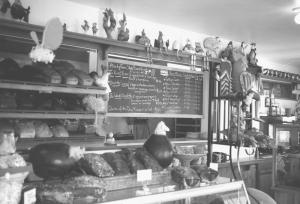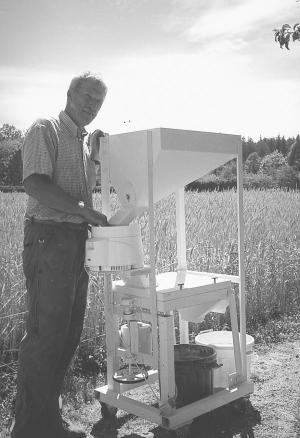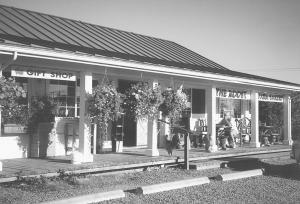2006 - Volume #30, Issue #5, Page #06
[ Sample Stories From This Issue | List of All Stories In This Issue | Print this story
| Read this issue]
They're Turning Flour Into Gold
 |
 |
 |
Their bread, sandwiches, and other products are all sold at The Roost, a bakery, plant nursery and gift shop they built with a neighboring family on the edge of the farm. It was the idea of adding value to grain that got them started.
"If you do the gross numbers on wheat, we grow enough wheat on five acres to make about 50,000 loaves of bread or about $200,000 in sales," calculates Crawford.
"But when we make sandwiches out of the bread, we triple our return, and that's just from the flour that goes into it."
Crawford found the gold in wheat the hard way, but he believes that other small acreage farmers could do the same with their products. When he and Yarish got interested in direct marketing farm products, they joined a tour to northern California to look at direct market apple orchards there. At the time, a glut of apples from China had depressed the U.S. market.
"The ones who were doing the best and having the most fun were baking apple pies and running a pie house," recalls Crawford. "I thought if we concentrated on our 10 acres, we could do something like that with flour rather than apples."
Crawford's plan was to grow the grain, mill it on site and bake breads and pastries with it doing all the labor themselves. The first step was learning about wheat and flour production.
The second step was going into business with a neighboring family, the Robinsons, and building a bakery. Working during the winter and doing most of the work themselves, Crawford, Ray Robinson and their wives took two years to build the bakery.
It also took Crawford about the same amount of time to get his wheat production and flour milling system up to speed. Using heavy inputs of fertilizer and irrigation, he quickly built his yields of hard red spring wheat up to the 80 bu. range.
A combine was easy to find, as he only needed a small one. "They are a dime a dozen on the prairie, as most of the farmers need big ones today," says Crawford. "It cost more to get it here to Vancouver Island than it did to buy it."
While the combine did a fair job on weed seeds and chaff, wheat for flour needs to be cleaner yet. Crawford got his hands on an old fanning mill that does a good job cleaning the wheat before running it through the mill.
Although Crawford and Robinson planned to market most of their bread as whole stone ground wheat, they needed finer flour for pastries. Crawford needed a sifter to remove the bran.
"You can buy one built for home use or a large commercial one for a big flour mill, but there's nothing in between," he says.
The only solution was to build one. Crawford designed a portable unit that is only 2 by 3 by 5 ft. high. It includes a hopper, a flourmill, a sifter and room for flour and bran tubs underneath.
He used 2 by 2-in. steel tubing for a 3-sided base on caster wheels and for the motor supports at the closed end. The uprights at the corners are angle iron, and the hopper and sifting table are sheet metal. A cover for the sifter clamps in place with simple T-screws.
He adapted the mill by replacing the steel burrs with stone burrs and mounted the mill beneath the hopper. The ground flour drops into the sifter powered by a used 1/3-hp motor. An offset shaft gives the sifter both a reciprocating motion to keep the flour moving across the screen and an oscillating motion to keep the fines moving through the screen.
Crawford has tried different types of screening, including professional grade metal screen. What he likes best is nylon mesh from the fabric store.
"It only costs pennies, but has 190 holes per square inch for very fine flour, something you can't get with metal screening," he says.
"The hopper holds a bushel of wheat, and the mill can do about 100 lbs. of whole wheat and the sifter can do about 50 lbs. of flour an hour," he says. "The bakery uses about 30 to 50 lbs. a day, so I gri

Click here to download page story appeared in.

Click here to read entire issue
To read the rest of this story, download this issue below or click here to register with your account number.




